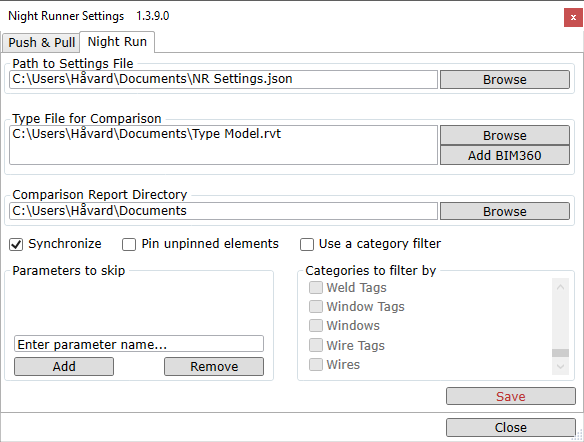One of the biggest challenges with delivering consistent data with Revit lies in the fact that the only way to solve it’s many performance issues is to split projects up in separate files. Once any cross disciplinary building design is separated into multiple files, each one of the files start living their own lives. On day one. Revit is great for small houses. Not so much for large hospitals and airports.
Luckily, this is not only my opinion. It is shared among a growing list of people. One of them is called Morten Ræder. Morten experienced this problem while working on an airport, and once he was done with the airport, and started working on the next big project, the two of us sat down to talk about how to solve this problem.
Fast forward a few years and there’s a tool in the market. It’s called Night Runner, its built by Dynamo Legend Dimitar Venkov and is being sold at a symbolic price as part of the Reope Toolbox – our combined installer for Revit automation.

How does it work, you ask, dear BIM manager?
You create one Revit file that contain all your standard Revit design elements, and any changes you apply to these elements get’s automatically distributed to theoretically unlimited number of Revit project files. We call that file a “Type File”. The “automatically” part above is driven by Revit Batch Processor and the settings that are controlled by you using the Revit addin UI.

We also built in manual Push and Pull functions that let’s you easily move and update content to and from any Revit model in your organization, through a simple UI. This does two things: it makes it much easier for your team to take ownership to the contents of the Type File, as they can easily Push changes they make in their project model to the Type File and eventually all project models. It also makes it much easier for you to manually distribute and update any changes you make in the Type File instantly to any project models.
An interesting side effect that this workflow has for me, is that I spend more time working in the Type File than the actual design models. This is great because it only contain one instance of every family, type and setting and is therefor quite light on it’s feet. One pro tip is to use Push to Many to instantly distribute design content changes:)
The list of things that Night Runner can automatically standardize is a rather long one, so please bear with me here:
- Families (Model and Annotation, anything from Doors to Title Blocks)
- System Families (Model and Annotation – anything from Ducts with Routing Preferences to Dimension Types)
- Types
- Materials (and their parameters)
- Object Styles
- View Types (Floor Plans, Elevations, Sections, Sheets, etc.)
- Fill Patterns
- Color Fill Legends
- Levels & Grids
- Legends
- Line Patterns
- Lines
- Project Information
- Group content (not Groups themselves)
- Schedule Graphics
- Scope & Section Boxes
- Text Types
- Units
- View Filters
- View Templates
- Worksets
- …and more.
I have to say that this automation workflow is not an anonymous one, like your data extraction scripts, etc. Your team will notice it, and ideally they will both interact with it and like it. They will like the effectiveness. But it’s a different way of working with Revit, and the key to success (as always) lies in a good implementation. Here are my tips for how to do that:
- Start small. Have few element types in your Type File in the beginning. Use the Category Filters to deselect Categories you dont need to Sync in the beginning.
- Turn on Sync as early as possible. Using Night Runner for only reporting has very low ROI, and the sooner your turn on synchronization, the earlier your teams get’s used to the way it works.
- Give your Type File the TLC it deserves. The quality of the outcome, which is consistent design data, depends on the quality of your Type File.
- Write documentation and guidelines for usage for your team. Our documentation will never be as good as the one you have, where you describe how it works in your project.
- Train, train and train your team, through short and precise sessions with QA at the end. It’s a scary workflow for people who are not used to it, but when you explain that changing the content in a Type File is no different from changing the content of a Revit file, just at a higher level, it demystifies it.
Morten and I presented Night Runner as one of three Revit automation workflows we built and implemented on the new Norwegian Government Quarter project in Oslo, Norway at Autodesk University 2022 in New Orleans, US. The session was given the Top Rated Case Study Award, and we received a long list of positive feedback. I wrote about it here a few days ago.
If you want to test this workflow, I suggest the following procedure:
- First decide if you want, should and can. If your project contains more than 1 file per discipline, is just about to get started and you feel motivated by automation, you’re good to go. If not, your contributions are probably better spend doing something else.
- Download the installer and activate the 30-day trial.
- Send us an email on [email protected] and say that you want to talk with us about how it works and how to best implement it with your team.
Good luck automating the biggest ‘sucks’ of Revit!

